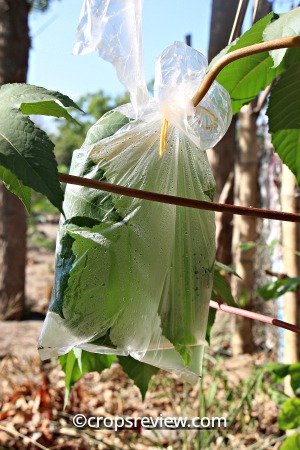To be more specific, what is transpiration in plants?
The special reference to plants should be proper and is not without basis. It is because this process is not exclusive to plants.
It also occurs in mushrooms.
This paper and its component pages relate to the kingdom Plantae.
The word is the noun ‘transpire‘ from Latin trans, meaning across or through, and spirare or breathe.
It is the natural process by which liquid water within the plant is converted to gas and, in this state of matter, lost via various aerial organs but primarily through the leaves.
Stated simply, it is the evaporation of water from plants.
Stephen Hales (1677-1761) referred to it as perspiration.
In 1727, Hales published Vegetable Staticks, his most important work which was on plant physiology.
There he reported how he measured the water that entered via the roots and that given off by the leaves. Here’s a quotation lifted from Rook (1964):

“In animals, it is the heart which sets the blood in motion and makes it continually circulate, but in vegetables, we can discover no other cause of the sap’s motion but the strong attraction of the capillary sap-vessels, assisted by the brisk undulations and vibrations caused by the sun’s warmth, whereby the sap is carried up to the top of the tallest trees and is there perspired off through the leaves: But when the surface of the tree is greatly diminished by the loss of its leaves, then also the perspiration and motion of the sap are proportionately diminished. . .”
Transpiration Is an Important Subject of Study in Plant Physiology
Transpiration is an important subject of study in plant physiology, the study of the physical and biochemical processes occuring in plants.
In particular, transpiration is a necessary inclusion in reviewing plant-water relations.
In turn, it is important to acquaint with plant functions that involve the participation of water because water performs both direct and indirect functions in crop growth and in crop production.
The change from liquid water to gas (or vapor or steam) is likewise a necessary attachment to the definition of transpiration because it is not the only means by which water is lost from plants.
This distinguishes it from guttation, the loss of water as liquid, the same liquid water that enters the plant through its roots.
Guttation water is commonly visible as droplets at the margins (vein endings) of leaves early in the morning.
Guttation only represents a minimal proportion of total water loss from plants, but it becomes significant under conditions of high relative humidity, cool air, and warm soil at night time where soil water is available.
These conditions favor water absorption but not transpiration.
Root pressure “pushes” the liquid water in the xylem tissue and out of leaves through specialized structures called hydathodes.
This is to relieve the plant of excessive hydrostatic pressure in the xylem due to a higher rate of water uptake compared to water loss.
An exceptional plant is a gabi or taro (Colocasia esculenta), a popular rootcrop that belongs to the monocots but has broad leaves and netted leaf venation.
According to Moore et al. (2003), a single leaf of this crop plant is capable of losing over 300 ml of water in one night by guttation.
Although a live plant may contain 70-90% or more moisture content, this water is not the same water from day to day.
Water within the plant is continuously removed and replaced.
In fact, the full amount of water in some plants can be possibly transpired and replaced with new water within one day under conditions that favor transpiration (Devlin 1975).
According to Moore et al. (2003), the rate of ascent of water from the roots to the leaves can be as fast as 75 cm or 0.75 m per minute.
To calculate the time duration to raise a volume of water from ground level to the top of a tree, we simply divide the height of the tree by the average rate of water ascent or height/rate of ascent.
Therefore, if we apply the above rate (0.75 m/min) to a tree with a height of 100 meters (a mere assumption that this tree has this rate of water ascent), it would take only 133.3 minutes or about 2 hours and 13 minutes (100 m ÷ 0.75 m/min = 133.3 min) for water to reach the top.
However, about 90% or more of the water that enters a plant through its roots are usually transpired from the surfaces of leaves.
Only less than 5% is retained by the plant for growth and less than 1% is used biochemically (Mader 1993; Hopkins 1999).
Further, the process of transpiration is not restricted to intact plants.
It also occurs in separated parts.
It contributes largely to the drying and shriveling of certain fruits and vegetables in market stalls.
REFERENCES
DEVLIN R. 1975. Plant Physiology. New York, NY: D. Van Nostrand Company. 600 p.
FEININGER A. 1968. Trees. New York, NY: The Viking Press. 116 p.
HOPKINS WG. 1999. Introduction to Plant Physiology. 2nd ed. New York, NY: John Wiley & Sons, Inc. p. 37-59.
MADER SS. 1993. Biology. Part 4: Plant Structure and Function. 4th ed. Dubuque, Iowa: Wm. C. Brown Publishers. p. 473-536.
MOORE R, CLARK WD, VODOPICH DS. 2003. Botany. 2nd ed. New York, NY: McGraw-Hill Companies, Inc. P. 496-520.
ROOK A (ed.). 1964. Stephen Hales. In: The Origins and Growth of Biology. Harmondsworth, Middlesex: Penguin Books Ltd. p. 202-214.
WENT FW, THE EDITORS OF LIFE. 1963. The Plants. New York: Time Incorporated. 194 p.
